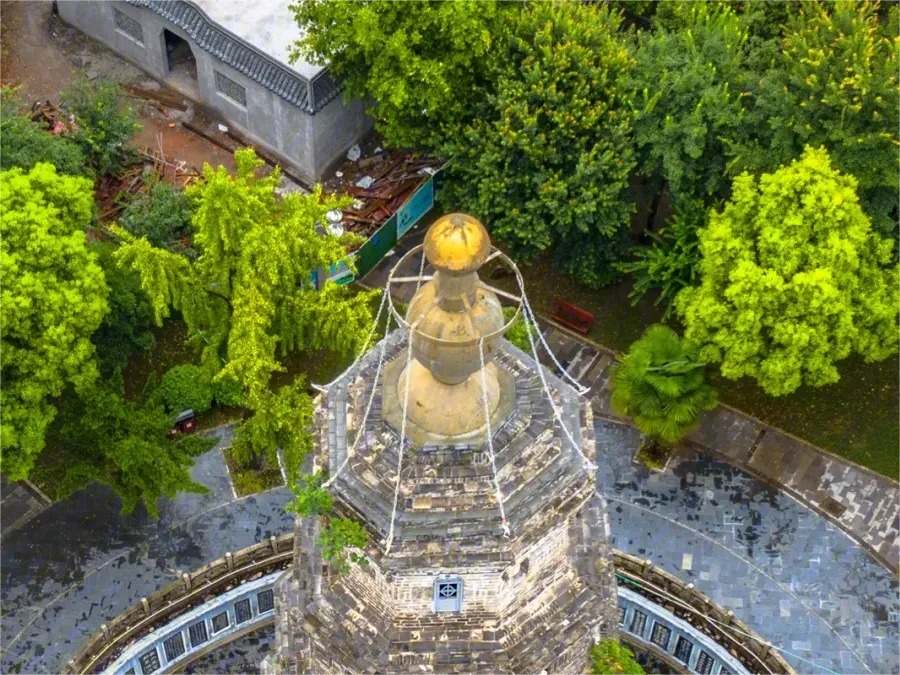Wanshou Pagoda (万寿宝塔), located in Wanshou Garden, Jingzhou, China, has a rich history dating back to the 27th year of the Ming Dynasty’s Jiajing era, which corresponds to the year 1548. Its construction was initiated by Prince Zhu Xianwei, who, under the command of his stepmother Empress Dowager Mao, sought to pray for the longevity of Emperor Jiajing. The pagoda was erected on the banks of the Yangtze River, specifically at Xiangbi Islet, and was completed four years later, earning the name Wanshou Pagoda, which translates to “Tower of Ten Thousand Longevities.” The legend surrounding its creation suggests that the pagoda played a role in calming the erratic behavior of a mysterious dragon believed to have caused the frequent breaches of the Yangtze River embankments in the Jingzhou and Jiangling areas during the Jiajing era.
Table of Contents
Basic Information
| Estimated Length of Tour | 1 – 2 hours |
| Ticket Price | Free |
| Opening Hours | 8.00 – 17.00; Last admission: 16.30 |
| Telephone Number | 0086-0716-8503149 |
Location and Transportation
Wanshou Pagoda is situated atop Guanyin Ji on the Jingzhou embankment of the Yangtze River, in the Shashi District of Jingzhou City, Hubei Province, China. The precise address is 90 Jingdi Road. To get there, you can take bus 5 or 17 and get off at Tongqu Road Intersection Stop (通衢路口站).
Highlights of Wanshou Pagoda
Architectural Style

The architectural style of Wanshou Pagoda reflects the essence of traditional Chinese craftsmanship. Standing at an impressive height of 40.76 meters, the pagoda boasts an octagonal shape with seven tiers. Its structure is a remarkable imitation of wood, constructed using brick and stone. The base of the pagoda is adorned with large stone pedestals, each featuring a white marble guardian pillar at its eight corners. The pagoda’s hollow interior houses a spiral staircase, allowing access to each tier. Notably, each level has four doors that open outward, and at the center of the first floor stands an 8-meter-tall statue of an Amitabha Buddha, symbolizing guidance and salvation.
Historical Artifacts

The fourth floor of Wanshou Pagoda holds a significant historical artifact – a weathered inscription on a stone tablet titled “Record of the Construction of Wanshou Pagoda by King Xian of Liao.” Inside and outside the pagoda, 87 niches are embedded into the walls, each enshrining a seated Buddha carved from white marble. The sculptures exhibit diverse expressions and exquisite details, showcasing the artistic mastery of the craftsmen.
Unique Bricks and Position

The bricks used in the construction of Wanshou Pagoda were donated by devout followers from 16 different provinces and counties across eight provinces in China. These bricks exhibit unique characteristics, with some being square in shape and adorned with intricate patterns. The diverse collection includes floral patterns, bas-reliefs of Buddha figures, and inscriptions in five different scripts – Han, Tibetan, Uighur, Mongolian, and Chinese. In total, there are 2,347 bricks contributing to the pagoda’s construction.
One of the distinctive features of Wanshou Pagoda is its unique position, with the lower part of the pagoda submerged 7.29 meters below the surface of the embankment. This phenomenon is attributed to the gradual elevation of the Yangtze River bed and water levels over the centuries, leading to the pagoda being enveloped by the rising embankment of the Jingzhou Great Dam.
Gilded Bronze Finial

Crowning the pagoda is a gilded bronze gourd-shaped finial, featuring the complete text of the Diamond Sutra, a Buddhist scripture, making it a rare and valuable cultural relic. Adjacent to Wanshou Pagoda, on its western side, a memorial pavilion was erected to commemorate the victory of the people of Jingzhou over the massive floods of the Yangtze River in 1998. The pavilion pays tribute to the brave individuals who sacrificed their lives during the anti-flood efforts. Together, Wanshou Pagoda and its surroundings stand as a testament to the rich history, cultural significance, and resilience of the people of Jingzhou.

